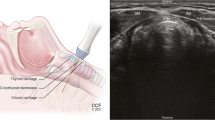Abstract
Although minimally invasive surgery (MIS) has been utilized in selective trauma patients, there a relative paucity of literature on its role in both blunt and penetrating trauma in the pediatric population. Our purpose is to review the current literature on the role of MIS in abdominal and thoracic pediatric trauma. A review of the literature, indications, risks, and benefits of MIS in trauma will be presented. Relevant literature was obtained from use of the PubMed database.



Similar content being viewed by others
References
Carnevale N, Baron N, Delany H (1977) Peritoneoscopy as an aid in the diagnosis of abdominal trauma: a preliminary report. J Trauma 17(8):634–641
Feliz A, Shultz B, McKenna C et al (2006) Diagnostic and therapeutic laparoscopy in pediatric abdominal trauma. J Pediatr Surg 41:72–77
Leppaniemi A, Haapiainem R (2003) Diagnostic laparoscopy in abdominal stab wounds: a prospective, randomized study. J Trauma 55:636–645
Marwan A, Harmon CM, Georgeson KE et al (2010) Use of laparoscopy in the management of pediatric abdominal trauma. J Trauma 69(4):761–769
Gaines BA, John JD (2010) The role of laparoscopy in pediatric trauma. Semin Pediatr Surg 19:300–303
O’Malley E, Boyle E, O’Callaghan A et al (2013) Role of laparoscopy in penetrating abdominal trauma: a systematic review. World J Surg 37:113–122
Kopelman TR, O’Neill PJ, Macias LH et al (2008) The utility of diagnostic laparoscopy in the evaluation of anterior abdominal stab wounds. Am J Surg 196:871–877
Kurkchubasche AG, Fendya DG, Tracy TF et al (1997) Blunt intestinal injury in children. Arch Surg 132:652–658
Garg N, St. Peter SD, Tsao K et al (2006) Minimally invasive management of thoracoabdominal penetrating trauma in a child. J Trauma 61:211–212
Gaines BA (2009) Intra-abdominal solid organ injury in children: diagnosis and treatment. J Trauma 67(2):135–139
Ditmars ML, Bongard F (1996) Laparoscopy for triage of penetrating trauma: the decision to explore. J Laparoendoscopic Surg 6(5):285–291
Ross SE, Dragon GM, O’Malley KF et al (1995) Morbidity of negative coeliotomy in trauma. Injury 26(6):393–394
Rossi P, Mullins D, Thal E (1993) Role of laparoscopy in the evaluation of abdominal trauma. Am J Surg 166(6):710–711
Fabian TC, Croce MA, Stewart RM et al (1993) A prospective analysis of diagnostic laparoscopy in trauma. Annals of Surg 217(5):557–565
Streck CJ, Lobe TE, Pietsch JB et al (2006) Laparoscopic repair of traumatic bowel injury in children. J Pediatr Surg 41:1864–1869
Ahmed N, Whelan J, Brownlee J et al (2005) The contribution of laparoscopy in evaluation of penetrating abdominal wounds. J Am Coll Surg 201:213–216
Villavicencio RT, Aucar JA (1999) Analysis of laparoscopy in trauma. J Am Coll Surg 189:11–20
Hasegawa T, Miki Y, Yoshioka Y et al (1997) Laparoscopic diagnosis of blunt abdominal trauma in children. Pediatr Surg Int 12:132–136
Crookes BA, Shackford SR, Gratton J et al (2010) “Never be wrong”: the morbidity of negative and delayed laparotomies after blunt trauma. J Trauma 69(6):1386–1391
Sosa JL, Arrillaga A, Puente I et al (1995) Laparoscopy in 121 consecutive patients with abdominal gunshot wound. J Trauma 39:501–506
Dicker RA, Sartorelli KH, McBride WJ et al (1996) Penetrating hepatic trauma in children: operating room or not? J Pediatr Surg 31(8):1189–1193
McMahon DJ, Sing RF, Hoff WS et al (1997) Laparoscopic transdiaphragmatic diagnostic pericardial window in the hemodynamically stable patient with penetrating chest trauma. Surg Endosc 11:474–475
Chen MK, Schropp KP, Lobe TE (1995) The use of minimal access surgery in pediatric trauma: a preliminary report. J Laparoendosc Surg 5:295–299
Komatsu T, Neri S, Fuziwara Y et al (2009) Video-assisted thoracoscopic surgery (VATS) for penetrating chest wound: thoracoscopic exploration and removal of a penetrating foreign body. Can J Surg 52(6):301–302
Author information
Authors and Affiliations
Corresponding author
Rights and permissions
About this article
Cite this article
Sharp, N.E., Holcomb, G.W. The role of minimally invasive surgery in pediatric trauma: a collective review. Pediatr Surg Int 29, 1013–1018 (2013). https://doi.org/10.1007/s00383-013-3401-x
Published:
Issue Date:
DOI: https://doi.org/10.1007/s00383-013-3401-x




